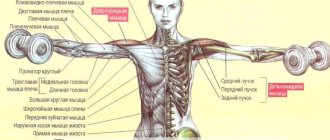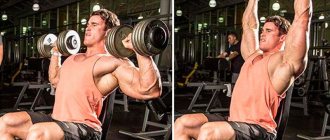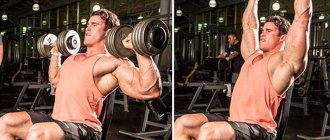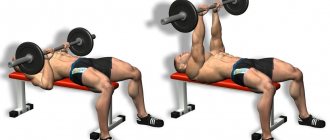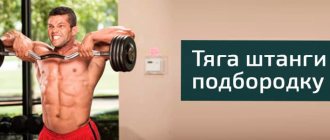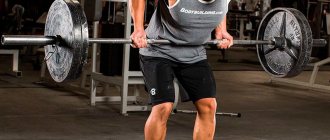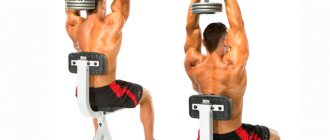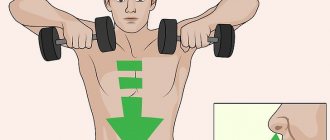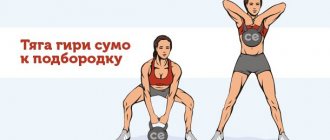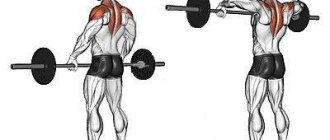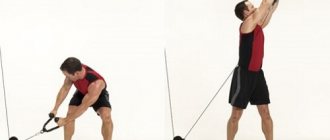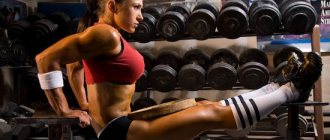Share:
What you need
- barbell
The barbell row to the chin is an exercise for increasing the strength and mass of the deltoid muscles. It is one of the isolated ones; here we are not very interested in the working weight. It is much more important to do the exercise with perfect technique and achieve good blood supply to the shoulders. When combined with dumbbell lateral swings, bench presses and bent-over rear delt raises, barbell chin rows will give your shoulders the 3-D volume effect that fitness and bodybuilding enthusiasts around the world are striving for. The technique of performing the exercise is not without pitfalls and requires careful consideration.
Today we will look at how to do this exercise correctly and what mistakes most often occur when performing it.
What muscles does the chin pull work?
I have already said that the chin row is aimed at working the deltoid muscles.
This is a small muscle mass that is located in the upper part of the brachialis muscle. Consists of 3 heads:
- Front.
From the name you can immediately understand where it is located. In front, above the pectoral muscles. Their main function is to raise your arm in front of you. And internal rotation. That is, turning the shoulder so that it is higher than the hand. - Average. This is the central muscle. She is responsible for raising her arms to her sides. The movement resembles the flapping of a bird's wing.
- Rear. For most athletes, it is this head that lags behind in development. Therefore, this exercise will help shape it. Its function is to move the arms back. And external rotation. That is, turning the shoulder so that it is lower than the hand.
And of course, another muscle that we can influence is:
- Trapezoid.
In particular, on its upper part. Indeed, when raising the elbows above shoulder levels, the deltoids lose almost all the load. But the trapezoid gets it. This is exactly what happens with a narrow grip.
And of course, the muscles are assistants. These include:
- Biceps. Responsible for bending the elbow.
- Forearm muscles. Helps to hold weight with weights in hands.
- Abdominal and lower back muscles. Keep our back straight. And they help you take the desired body position.
Knowing the functions of the target muscles, we can slightly modify the exercise. Mix the accent between the heads of the deltas. What I mean?
Target muscles
When performing chin pulls, the athlete focuses on the middle parts of the deltoid muscles. At the same time, the following indirect loads are received: the anterior deltas, trapezius muscles, scapular and serratus muscles, and biceps. It is worth noting that medium beams are worked using standard techniques. If you slightly change the way the element is performed, you will be able to shift the emphasis of the load to the trapezoid. We'll talk more about this in the following sections.
Recommendations for implementation
As you already understand, the delta muscles work in three planes. Lifting forward and to the sides, as well as pulling back. But there are some more functions.
Shoulder rotation during lifting
If we hold the hand below the elbow when lifting, then the entire load will go to the anterior and middle delta. But once we add external rotation to the movement. That is, when lifting we will twist our shoulder back. Then the rear delta will also connect. And we will be able to immediately influence three heads.
Body tilt
During normal execution, the middle deltoid and slightly the rear deltoid receive more load. That is, we are talking about traction with a flat body. But if we want to turn this exercise into a good tool for forming the rear delt. Then you should lean forward a little. And immediately we will see the difference. Now the arms are raised not to the side, but back. Performing the main functions of the rear deltas.
Body position relative to the projectile
This technique cannot be used with every weight. And it is not used very often, since there are many other exercises for the shoulders. Such as: DUMBBELL SWINGS ON AN INCLINE or SIDEWAY FLOW. And athletes give preference to them. But still, for general development, it will be useful to know. If we get close to the burden. Our movement will occur due to the middle deltas. Since the elbows will diverge to the sides above the body. If we move back a little. Then part of the load will transfer to the front heads. But the main thing here is not to overdo it. After all, if we move too far away, the exercise will turn into swinging in front of us.
Grip width
I have already mentioned this indirectly. With a wide grip, we will lift the weight using the deltoid muscles. Since with such a position of the hands it is more difficult to raise the shoulders up to engage the trapezius. And with a narrow grip, this is easier to do. Therefore, it is used if they want to develop the upper trapezius muscles.
As you can see, this exercise can be used for any need. But for some reason he rarely uses the chin pull now. Giving preference to presses, swings and exercise machines.
Contraindications
There are no serious contraindications to traction. That is, if you can go to the gym and do bodybuilding, then you can also do deadlifts.
The only exception is shoulder injuries. In this case, I do not recommend doing stretches and recommend limiting yourself to working with minimal weights in isolating movements.
If pain occurs not only during the exercise, but also after, then shoulder training should be temporarily removed from the program and consult a doctor.
Chin Pull Options
Barbell Chin Row
Rows to the chin with a barbell
The barbell is used most often in deadlifts. Most likely it's a matter of habit. Although performing the exercise with a wide stance and using a barbell is quite comfortable. Our elbows are fixed using a bar and because of this, a large number of stabilizer muscles are excluded. But if we are talking about a narrow grip, then you can forget about comfort. Since the same fixation of the hands with the help of the bar will now perform a bad role. Namely, when lifting, our hands will bend at an unnatural angle. And if your joints are not elastic, then you will experience pain every time you lift. But there is a solution to this problem for those who like barbell rows. We are talking about using a curved bar, the so-called EZ, instead of the usual flat bar. It will be more comfortable to hold onto it. When working with a barbell, we can not only change the grip width, but also calmly lean forward. Thus, the emphasis will shift to the rear delta. Well, the most important advantage in using this weight is the time it takes to complete it.
Chin row with dumbbells
Dumbbell Rows
I think for most athletes, the first thing that comes to mind after the barbell is dumbbells. After all, these are two of the most popular bodybuilder training equipment. By working with dumbbells, we can engage a large number of stabilizer muscles. This will trigger their development. But this will make it a little more difficult to focus on the work of the deltoids or trapezius. And since the hands are not fixed by the bar. This means that we automatically eliminate the problem with bending in the elbow joint. We can also lift the dumbbells as far apart as possible, thereby engaging the deltoids. Or close by turning on the trapeze. And of course, due to the absence of a bar, we can increase the amplitude of movement and turn the shoulder back a little when lifting. That is, use rotation and also connect the rear head to the work. And it turns out that the entire delta will work in the exercise.
Chin Pull in Smith
Smith Chin Row
The Smith machine is a machine in which the bar of a barbell moves up and down along two guides. Thanks to this, it is possible to eliminate the work of the stabilizer muscles and target the core muscles. For beginners, this simulator will help you practice your technique. Professionals use the Smith machine only for recovery training. Or when they work on relief. But of course this is a matter of habit. And if you feel that your deltoids or trapezius work better in this simulator, then feel free to work in it. It also gives you the opportunity to move further away from the bar. After all, it is fixed and thanks to this it will not go anywhere. This change in body position shifted the emphasis to the anterior delta. So be sure to experiment with this option.
How to choose a working weight
How much to hang on the bar in this exercise is determined by the standard bodybuilding goal:
You need to perform a given number of repetitions in a set, with the condition that the last movement will be a failure or close to it.
In bar rows to the chest or chin, the working weight can vary depending on the number of repetitions in the approach. As a rule, work on mass and relief occurs in the range of 6-15 repetitions . The rule is simple: the heavier the projectile, the fewer repetitions in the approach, and vice versa.
Here's an example:
- Let's say you decide that you can do pull-ups with a barbell with a weight of 30 kg for 8 reps in a set.
- Collect a 15 kg apparatus (50% of the planned weight) and do a warm-up set or two of 8-12 reps.
- Add weights up to 30kg and perform as many reps as possible with perfect form.
- Let's say it happened 15 times. This means you can add 10%-15% to the weight on the bar (two weights of 2.5 kg each) and try again.
- If it doesn’t work out and you hit 6 reps, no big deal. Take off 10-15%, rest and do another set.
- If you are now able to complete 8-10 repetitions per set, congratulations, you have found the working weight.
Please note: standing barbell pull-ups are among the most dangerous exercises for shoulder health. The reason is that athletes overestimate their capabilities - too much weight of the equipment, lack of technique, cheating, uncontrolled movement (throw) of the barbell in the lowering phase, incorrectly chosen grip width and too increased amplitude.
Chin row on a block machine
Cable Pulldown
This is the last of the variations I would like to talk about. It is also very effective, and at the same time the safest. After all, the crossover blocks are fixed and there is no way they can fall on us. And thanks to the wide variety of handles: cable, curved, straight. Everyone will be able to choose the one they need, and thereby reduce discomfort when performing. This option creates almost the same load as training with free weights. Therefore, you can safely use it in your training. Just to get the effect of such traction, you will need to stand close to the simulator. So that the weight of the blocks pulls, creating a load vertically downwards. Thereby forcing the deltas or trapezoid to work in static tension.
Read also[edit | edit code]
- Raider chest thrust
- Pulling the block to the side with both hands
- Pulling the block down with straight arms
- Wide grip pulldown
- Seated chest row
- Standing chest row
- Seated row of block to the waist
- Block row for biceps
- Vertical block thrust
- Upper pulley to chest
- Horizontal block thrust
- Head pull on a high block
- Abdominal row on the machine
- Pull the lower block forward
- Smith One Arm Row
- Standing one-arm row
Execution technique
Before you start doing the exercise, choose the option that suits you.
Initial position:
- Take the weight of your choice in your hands. If it's a barbell or Smith machine, then place your hands on the bar, choosing the desired grip width. In a block trainer for a narrow grip, a cable handle is usually used. And for a wide one, a long straight handle.
- If you plan to use the deltoids in your work, then you need to lower your shoulders down, thereby stretching the trapezius as much as possible.
Important!
Although the exercise is called a barbell row to the chin, with a wide grip we will not pull it to that level. Basically, the lift occurs to the middle of the pectoral muscles.
Performance:
- After you have taken the starting position, as you exhale, we begin to pull the weight up. At the same time, if we work on deltoids, we must ensure that the elbows do not rise above the level of the cries.
- After a short pause, while inhaling, lower your arms down.
Don't forget that the movement should resemble a deadlift, not a swing. Therefore, choose a weight that provides enough resistance to your muscles.
Advantages of wide and narrow grips
A wide grip allows you to focus on working the middle deltoids.
This is precisely the goal of most athletes who use pull-ups. In addition, placing the palms wide on the bar helps reduce the range of motion, which prevents the elbows from being raised high and protects the shoulder joints from dislocation or sprain. We can say that a wide grip is preferable for beginner athletes with weak joint ligaments and tendons. A narrow grip helps to shift the emphasis of the load on the trapezius muscle and thereby visually highlight it and make it more voluminous. It is also worth noting that narrow palm placement on the bar increases tension in the wrist and shoulder joints. Therefore, this exercise is preferable for experienced bodybuilders. For beginner athletes, instead of close-grip pull-ups, we recommend using safer shrugs with dumbbells to develop the trapezius.
Tips for Maximum Productivity
- Be sure to warm up at the beginning of your workout and just before you lift. I think it’s no secret that the shoulder joint is most susceptible to injury. And at the same time, he participates in almost every exercise for developing the upper body. Therefore, its safety is very important to us. Take 5-10 minutes to warm up your shoulder muscles and make them more elastic. And before each new exercise, do 1-2 warm-up approaches.
- Avoid performing chin pulls at the beginning of a shoulder workout. If you want to develop big and massive shoulders, then you should do heavy compound exercises in the beginning. And after them, finish off the muscles with lighter isolated exercises. Which is the pull to the chin.
- Eliminate inertia from the exercise. This is extremely important! I have already talked about how important it is to take care of your shoulders. Therefore, you do not need to relax your deltoids in the upper position so that the weight you choose falls down by inertia.
- Choose a multi-repetitive work mode. Isolated exercises are not intended for strength work (at least while you are a beginner). Therefore, it is better to take less weight, but do a little more repetitions. Basically, choose a range from 12-20 times in 3-4 approaches.
- Use all execution variations. This will help to load the muscles in a new way. By making your workouts more varied. And it will give you the opportunity to work out all muscle fibers.
Basic errors during execution
Too much weight
Many people think that the more weight they lift, the bigger their muscles will become. Of course there is a certain connection here. But they forget the most important detail. The weight you work with must be controlled. And if it is too big, then this is out of the question. And instead of big muscles, these athletes will end up with a shoulder injury. So work on your technique first. And only then, as your experience and muscles grow, the working weight increases. But do not forget that this exercise is isolated. Therefore, the burden will always be less than in the same SEATED DUMBBELL PRESS.
Round back during deadlift
Some people confuse a slight tilt of the body with a rounded back. To avoid this, I will try to explain this point. When bending forward, we keep our back straight and our shoulder blades apart. This is done to eliminate the trapezoid from the movement. This way we will only load the rear delts. If we work in a classical style, then our body should be in an even position. By doing this we reduce the pressure load on our spine. But as soon as we round our back, this load becomes uncontrollable. And can lead to displacement of intervertebral discs.
As you can see, the exercise is a bit difficult. But it is extremely effective when it comes to the development of deltas and trapezoids. Before you begin, it would be a good idea to study this material and work on your technique. Pay special attention to mistakes and do not make them. And then your training will bear fruit in the form of good results. And you will never know about injuries.
Good luck to everyone in your training!
